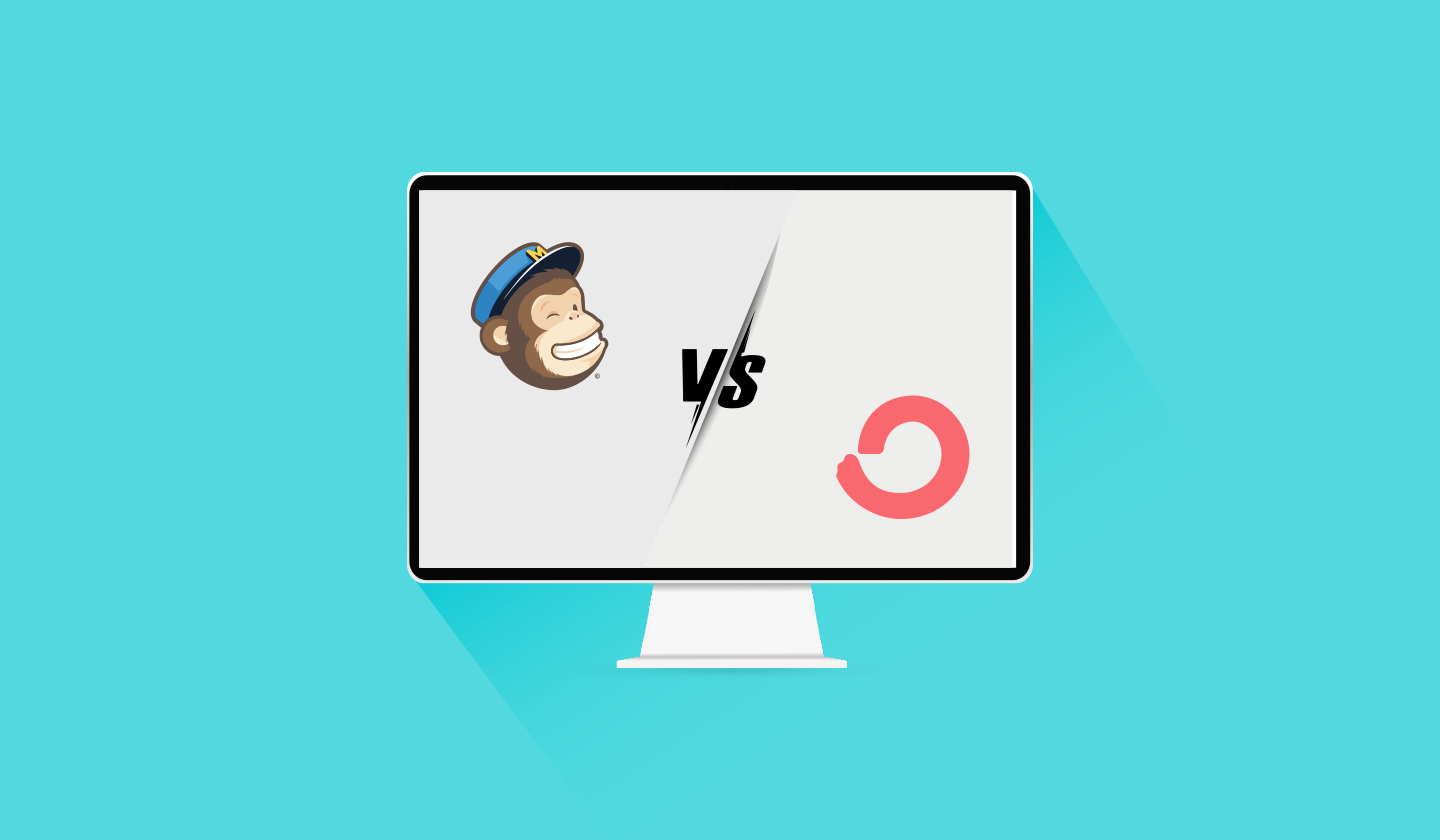We get it. As an email marketer, all you want is to design emails that would give tough competition to Picasso’s paintings and send emails that successfully land in your recipient’s inbox.
High-functioning masterpieces.
Thanks to Unlayer and its advanced customization features, designing emails that can easily catch eyeballs has been taken care of. Now the question is, which of the two leading email marketing softwares - ConvertKit vs Mailchimp - is the best pick for sending emails? 🤔
Choosing between two softwares that have earned almost equivalent yet massive popularity over the years is tricky for obvious reasons. So, we’ve made a detailed comparison of their offerings to help you make a quicker and better decision.
But let’s go step by step. So, we’ll start by discussing how you can create engaging emails using Unlayer.
Design High-performing Emails Faster With Unlayer
With 4.48 billion email users globally and 361.6 billion emails sent and received each day, how can you make your emails steal your recipient’s attention in a crowded inbox?
The answer is simple: design them with Unlayer.
Using Unlayer’s drag-and-drop editor, you can create customized, brand-centric emails and personalized email designs efficiently. Plus, emails created with Unlayer render perfectly across all devices and email clients.
In case you were thinking of using Mailchimp’s or ConvertKit’s editor for email designs, here’s why you need to switch to the OG - Unlayer:
Both Mailchimp and ConvertKit, wonderful in their own right, struggle when it comes to their capacity to offer a mature editor for designing impactful emails. This is why we suggest that, irrespective of the tool you eventually choose to send your emails, you opt for the best email design tool in the market —-> Unlayer. ⭐
Here’s a list of features that make Unlayer the top email editor in the market:
A user-friendly drag-and-drop editor
Comprehensive documentation
Custom tools
Custom blocks as reusable elements
Mobile responsive content
Code samples and demos
Merge tags for email personalization
The choice to hide or display items on the mobile version
Team collaboration to streamline the workflow process
Custom cloud storage or self-hosted storage
No limit on the usability of tools
Language support
Playground to see how the product works
Roles and access management
AI features
Designing emails with Unlayer saves you from the hassle of hiring a designer or developer and enables you to create high-performing emails efficiently.
Want to know how to create beautiful and responsive emails with Unlayer? Watch this video.
ConvertKit Vs. Mailchimp: Battle of The Top Email Marketing Software
It’s time for a big decision.

You’re about to pick something that’ll directly influence your business’s ROI, interaction with customers, and brand identity. So, to help you pick the best option, we will discuss the strengths and weaknesses of each software one by one and uncover which software weighs heavily on the other.
Note: We’re not biased towards any software. This analysis is based on
Our own experience with the respective software and
Common and recurring reviews shared by their users
Humble bragging 🙈: Both Mailchimp and ConvertKit effortlessly and seamlessly work with Unlayer and have resulted in successful email campaigns.
Ideal Customer Persona
Let’s start with the most important one.
Who you are and what your use case is, alone is quite a pivotal factor in deciding which software you should opt for.
Mailchimp is perfect for small to medium-sized businesses with over 2000 subscribers. Its free plan offers all the features necessary to run successful email marketing campaigns.
Notice how we said necessary and not desired.
To avail yourself of extra features, you must choose its paid plans, which are on the pricier side. We’ll discuss the prices in detail in the section below.
However, if you’re a content creator, blogger, or solopreneur looking to build a business online and sell courses, coaching, or a membership, ConvertKit is the perfect pick for you. The major reason behind this is that ConvertKit was created by a content creator himself and is tailor-made to cater to all the pain points and needs of a content creator or blogger.
In a nutshell,
If you want to launch larger email marketing campaigns or send emails as one of the tasks of your marketing campaigns, opt for Mailchimp.
But if you want more control over your email campaigns and want them to meet certain standards or goals, choose ConvertKit.
Now, let’s discuss the strengths and weaknesses of each tool in terms of features and functionalities.
Ease of Use
With so many tasks at hand, you’d want a tool that can automate maximum work for you with minimum cognitive load.

However, Mailchimp’s editor is a little complicated to get a hold of for people who aren’t tech-savvy or are just beginning.
The most common problem users face is that the Mailchimp’s editor does not support UNDO or REDO. Also, there's no Autosave. This, along with a not-so-intuitive list management and reporting features, may become a deal breaker for some.
For others, Mailchimp might take time to get a hold of it completely, but once they do, it’s worth every penny.
On the other hand, ConvertKit is quite simple and straightforward to use, and it is rated highly for its easiest writing experience. Even a newbie can run email campaigns with it easily.
Winner = ConvertKit 🏆
Automation
ConvertKit provides advanced automation features. They’re visual automation feature offers more than just standard automation and has bragged many praises from its users.
ConvertKit has given special attention to its automation sequences, and their ‘if this, then that’ automation feature has become the talk of the SaaS town.
On the other hand, Mailchimp also offers a visual automation builder and provides a broader range of campaigns to automate. Both Mailchimp and ConvertKit do not offer automation in their free plans. So, if you want to avail of their automation services, you’d have to switch to their paid versions.
Winner = Both 🫱🏻🫲🏽
List Management
You can create only one list in ConvertKit, but this list can be segmented according to your subscriber’s behavior, interest, and activity with the help of tags.
On the other hand, you can create multiple lists on Mailchimp, but their list management offers more features. It’s perfect if you’re creating lists based on purpose or campaigns. Once you create lists on Mailchimp, you can segment them in greater detail than in ConvertKit.
However, the problem with Mailchimp is that a single contact can be present in more than one list. This could become an unpleasant situation because:
Mailchimp charges double for the same contact.
The same contact receives an email twice if you send emails according to campaign or email type.
So, even though Mailchimp offers more features, list management is a lot more hassle-free and fruitful in ConvertKit.
Winner = ConvertKit 🏆
Pricing
Elephant’s chunk of Mailchimp users opt for it because their free version offers all the features needed to run an email campaign.
Mailchimp's free version is best for small to mid-sized businesses under a limited budget, offering 1000 sends for >1500 contacts.
You must opt for their paid plans to use advanced features like automation, campaign management, reporting, or testing.
On the other hand, ConvertKit offers a free version of up to 1000 subscribers with limited features. And you’d have to opt for their paid plans to avail of more advanced features.
So, in terms of pricing, Mailchimp is the better option for small to mid-sized businesses.
Winner = Mailchimp 🏆
Testing
This is one area where Mailchimp easily has the upper hand. ConvertKit lets you test email subject lines ONLY.
On the other hand, Mailchimp allows you to A/B test all elements of an email, like email design, subject line, and send time, allowing us to identify the best of each element. But it’s also important to note that Mailchimp does not offer testing in their free plan.
This can be a deal breaker for many users as email tests help you decide what works best for your campaigns and what doesn’t.
Winner = Mailchimp 🏆
Integrations
Another area where Mailchimp clearly has a win is integrations. Mailchimp offers over 300+ integrations to run successful campaigns. The cherry on top is that they’re available in their free plan as well.
ConvertKit offers up to 80 integrations with popular platforms, and these integrations are available only through their paid plans.
Again, if integration is a deal-breaker factor for you, then Mailchimp has a clear win.
Winner = Mailchimp 🏆
Support
Both Mailchimp and ConvertKit offer excellent customer support to their users.
Mailchimp’s free plan offers support through email, while the paid plans assist through live chat and phone. In addition to this, they also provide video tutorials and informative content blogs.
On the other hand, live chat and email support are only available on ConvertKit’s paid plans, but they do offer community support, courses to grow one’s audience, and access to network and learn from ConvertKit’s creators.
Both tools offer support to their users in unique and valuable ways. So, we’d give one to both in this area.
Winner = Both 🫱🏻🫲🏽
Report
Even though ConvertKit offers reporting on all plans, there’s a lot they can improve in that area. Reporting and A/B testing are two features that should be enhanced in ConvertKit to be a leading software.
Meanwhile, Mailchimp provides advanced reporting through AI-generated monitoring. You must know that Mailchimp’s free version and Essential plan offer limited reporting, whereas Standard and Premium plans offer advanced reporting.
Winner = Mailchimp 🏆

Final Thoughts
As you can see, both of these leading software companies have their own strengths and weaknesses. To decide which tool to opt for, consider factors like your business’s budget, use case, email list size, and priorities.
Both Mailchimp and ConvertKit integrate seamlessly with Unlayer and enable users to send responsive and beautiful-looking emails without any friction. We really hope this feature face-off helps you make a more informed choice about which email marketing software you should opt for.
We also answered some frequently asked questions related to Mailchimp vs ConvertKit for you. Have a look, as we might have answered a question running through your head.
FAQs About ConvertKit vs. Mailchimp
We’ve done detailed research, and the following are a few questions that everyone has been asking regarding the two software.
Which email marketing software has a better email deliverability rate, Mailchimp or ConvertKit?
According to emailtooltester, Mailchimp has an email deliverability rate of 91.93%, whereas ConvertKit has an email deliverability rate of 87.26%.
This means Mailchimp has a better email deliverability rate.
2. What is a cheaper alternative for Mailchimp?
MailerLite, Brevo, and Moosend are three budget-friendly alternatives for Mailchimp. They may not provide the same features as Mailchimp, but they allow you to send successful and conversion-worthy campaigns at a low cost.
3. Is Mailchimp suitable for beginners?
Yes, even though Mailchimp’s complicated user interface might trouble beginners at first but once they get a hold of it, it’s a smooth ship to sail. Also, the abundance of features, pre-made templates, and low cost make Mailchimp an excellent choice for beginners.


